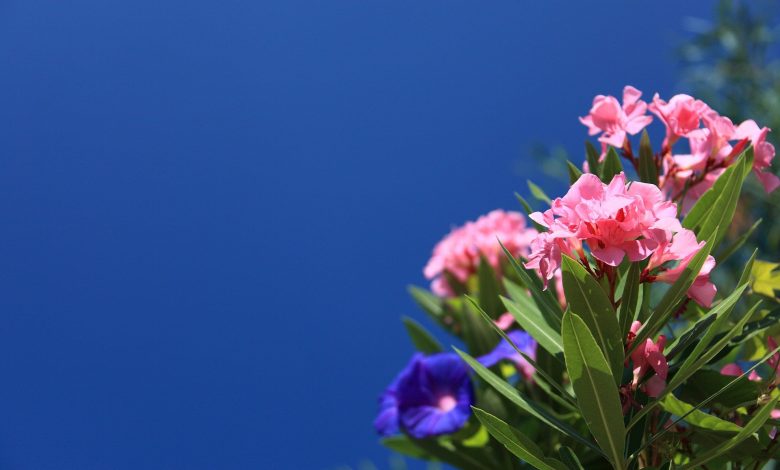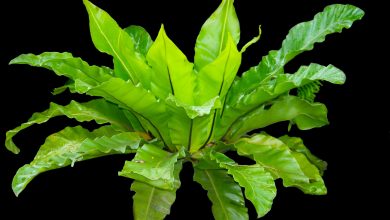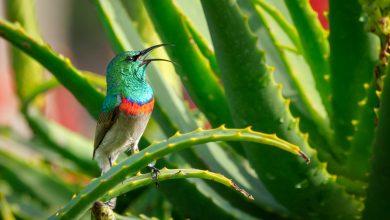Deadly Gardening: Plants for Poisonous Gardens

In the mid-1700’s the 1st Duke of Northumberland commissioned the creation of a garden to a famous landscape architect who bore the moniker “Capability Brown.” And it was this fancy project that would lay the foundation for the modern-day Alnwick Gardens.
After the completion of the gorgeous garden, with each century that passed, every superseding duke made slight changes according to their tastes and preferences. The 3rd Duke of Northumberland was an avid plant collector who brought seeds from all over the world, and the 4th duke ordered the creation of a new conservatory to house the overwhelming number of plant species that was growing by the day. By the end of the Alnwick Gardens’ development, it was laden with lime trees, yew topiaries, and an abundant acreage of flowers.
Fast forward to the 21st century. In 2005, the Alnwick Gardens were updated to feature a rare “poison garden.” This new addition was decorated solely with poisonous plants, including strychnine, hemlock, ricin, foxglove, deadly nightshade, angels trumpet, and laburnum.
Although the glamorous attraction seems like it would be out of reach. If you’re daring enough and have a curiosity for the more dangerous species of plants, you can grow your very own poison garden at home. Creating a poison garden is a great project for an advanced gardening enthusiast. After all, what could be cooler than having a few rare plans and a very unique garden to show off to other enthusiasts and anyone who visits?
But before we proceed – a few well-placed words of caution are definitely needed. If you have children or pets, don’t go growing a garden that might end up harming either of them. Growing a poison garden is a relatively complex and potentially dangerous hobby. As such, it’s only suited for advanced gardeners looking to take up a challenge in a more unique realm of gardening.
Without further ado, let’s jump in and learn about how you can create your very own poison garden, as well as cover some of the plants that it could potentially house.

What You Need To Keep In Mind When Creating A Poison Garden
Everything that’ll go into your poison garden is going to sound like it’s from Sally’s cookbook, in The Nightmare Before Christmas. Before creating a garden that sounds like its contents would end up in a witches brew, you should carefully plan out the landscape to make sure that these plants have little to no interaction with anything else you may be growing. And if others are going to be taking a gander at the odd specimens you decided to keep, you should carefully keep these plants behind bars to prevent any unwanted mishaps.
At any rate, there’s a lot of fun to be had in putting one of these gardens together. Your garden of poisonous plants can easily be turned into a work of art, especially if you can provide a little bit of insight into the history and culture behind some of the plants that you choose to include. Anyhow, there are a few things you should keep in mind when you’re growing poisonous plants – let’s gloss over the most important details so you can get started.
Safety
If the entirety of your garden is going to be focused on poisonous plants, you shouldn’t have to worry about keeping your plants separated from others. But if you’re also growing your usual garden plants that require a little bit of hands-on maintenance – you’re not going to want to have poisonous plants in close proximity to them, while you work on your garden.
That being said, it’s also a good idea to keep your poisonous plants away from where others might end up walking, as it would be incredibly unfortunate to have stinging nettle brush by your leg.
Planning
Perhaps you don’t just want poisonous plants, but something also aesthetically pleasing. There happen to be quite a few toxic and poisonous plants that provide a lot of beautifully colored foliage.
Wouldn’t it’d be interesting to have a poison garden full of rich blues and deep purples? Regardless of the layout you have in mind, there’s certainly a handful of ways to create something that looks absolutely stunning. Just remember to arrange your garden appropriately ahead of time.
Precautions
Remember, you shouldn’t have the intention of hurting anyone with your garden. It’s best to make sure that there is some indication of whether or not someone should go near your plants.
Some “Danger” or “Alert” signs could be a fun craft project if you chose to create something personalized to let the viewers of your garden know exactly what they are walking into.
It would also be best to indicate what exactly is going to happen if someone touched a certain plant. That way, the correct precautions could be taken in case someone does accidentally poison themselves or ends up with a nasty rash.
Poisonous Plants That You Can Cultivate

Lily Of The Valley
Lily of the valley is a beautiful plant commonly used in wedding bouquets and perfumes. In religious paintings, lily of the valley was even considered to be a sign of Christ’s Second Coming.
Realistically, this plant is actually a wolf in sheep’s clothing. Every single part of the plant is highly poisonous. And if someone were to ingest even the smallest amount, it can cause abdominal pain, vomiting, reduced heart rate, blurred vision, drowsiness, and nasty red skin rashes. Though, something that might make this flower seem aesthetically appealing to some gardeners is that it yields small red berries, which add a beautiful accent to any shrubbery or patch.
The chemicals responsible for its poisonous qualities are referred to as cardiac glycosides or cardenolides. And this particular plant actually happens to contain nearly 38 of these deadly poisons. Yikes!
Castor Oil Plant (Ricin)
We’ve all heard of castor beans or castor oil. But if you take a look at its Latin name “Ricinus communis,” you’ll notice the name of one of the deadliest man-made poisons happens to be in there. That’s right, ricin actually comes from the castor oil plant!
It’s been known for a long time that there’s actually some medicinal benefits of castor oil, but it’s going to be a common theme in this post that looks can be incredibly deceiving.
The spiny purple seed pods of the castor oil plant contain large bean-like, highly poisonous seeds, which make the castor plant the most poisonous common plant in the world. An overdose can cause nausea, diarrhea, tachycardia, hypertension, and seizures, all of which could last for an entire week and even lead to death.
However, despite the horrific description, this is a very beautiful plant that adds some gorgeous accents as it transitions from a greenish shade to a nice deep purple as it matures.
Foxglove
Foxglove, also known as “Digitalis purpurea,” is a beautiful and incredibly common poisonous biennial plant. This beautiful purple plant is used for medical purposes despite the fact that it contains toxic cardenolides, similar to Lily of the Valley. A common drug sold under the brand name of Lanoxin is made with a chemical extracted from the plant called digoxin. Both the plant itself, as well as drugs containing its extract, are commonly used to treat various heart conditions.
However, the same chemical that’s used to save lives is also highly poisonous when it’s used the wrong way. The side effects include nausea, diarrhea, yellowing of the eyes, cardiac arrhythmia, weakness, and dilated pupils, to say the least. The list of side effects (not to mention the possibility of death) might scare off even the bravest gardeners. But those educated and skilled enough to undertake the challenge (and live to tell the tale) would get to enjoy the hues that this gorgeous plant has to offer to any poison garden.
Oleander
Oleander is an ornamental plant that always stands out because of its bright pink color and deep red border. It’s actually a type of small tree that bears an unfortunately dark history of being used as a poison. All parts of the plant are highly poisonous, and you should steer clear from ingesting oleander, touching its sap, and even inhaling smoke from a burning oleander shrub.
Again we’re running into cardiac glycosides, two of which are unique this time around. One of them being called oleandrin and the other oleandrigenin. The immediate effect of ingesting the plant has a direct impact on the heart and the central nervous system. The poison will also immediately hurt the gastrointestinal tract, causing vomiting, excess salivation, bloody diarrhea, and severe abdominal pain along with cramping.
But it doesn’t stop there! After the initial effects, the worst is yet to come. The unfortunate victim will come face to face with irregular heart rates and a total dysregulation of the circulatory system, which could cause tremors, spasms, seizures, and potentially even a coma.
But despite the horrifying list of potential dangers – it’s actually a pretty common garden plant in modern times, albeit a very dangerous one! If you’re up for a risky endeavor, growing an oleander plant will yield a stunning sparse-leafed shrub with mesmerizing colorful flowers that could really top-off your garden in an aesthetic sense.

Poison Hemlock
Hemlock, or Conium maculatum, comes with a lot of lore and interesting history that involves both Jesus Christ and the Greek philosopher Socrates. There’s a myth driving from Christianity that would suggest that the hemlock plant wasn’t always poisonous and that it became poisonous after growing near Jesus’ crucifixion. Socrates was similarly sentenced to death because of his beliefs, and he chose to die by poisoning himself with a brew made from this very plant.
So why is hemlock dangerous? Hemlock contains a highly toxic chemical called coniine, which can be found in every single part of the plant. This includes the stem, the branches, leaves, and any fruit the hemlock plant might bear.
The poison blocks the muscular function to the extent that it can easily cause asphyxiation. It’s commonly documented that animals are tempted to eat the fruit and the leaves of the poisonous hemlock plant. So steer clear of this one if you have any pets that might come in contact with it.
However, for some gardeners with a knack for danger – the large clusters of beautiful white flowers this thin-stemmed plant produces as it blooms may well be worth the risk.
Mistletoe
Merry Christmas! I’m sure we all have some kind of sentimental feeling when we hear the word mistletoe because of its traditional use in Christmas celebrations.
But did you know that mistletoe actually has a meaningful symbolism in several ancient cultures too? The celts saw mistletoe as a representation of a gift from one of their gods, while the Romans associated mistletoe with peace, love, and understanding, where they hung mistletoe about their doors during saturnalia.
However, it’s not all that jolly! This plant contains a high concentration of phoratoxin and tyramine. Combined, they may cause blurred vision, diarrhea, nausea, and even vomiting. It could also have severe cardiac implications, including seizures and hypertension or, in rare cases, cardiac arrest. But, as long as you don’t ingest the plant – you’ll be perfectly fine!
Being one of the least-dangerous plants on our list, it’s worth noting that it makes for an excellent addition to any garden, poisonous or otherwise. However, keep in mind that it’s an invasive plant and can quickly start to strangle its neighbors.
Belladonna (Deadly Nightshade)
Both of its names – Belladonna, or deadly nightshade – make this plant sound dark and ominous no matter how you look at it. An old folk tale suggests that European witches once made a concoction containing belladonna, opium poppy, monkshood, and poison hemlock to induce hallucinations in one’s sleep.
An old tradition stemming from the Carpathian Mountains even involved a ritual that involved making an offering of deadly nightshade for a woman to enhance her beauty and attractiveness. She would enter the field on a Sunday with her mother wearing her finest clothes, carrying a bag of bread, salt, and Brandy. She would then dig up a deadly nightshade root and leave each of the items she was carrying in its place. On her way home, she would carry the poisonous root on the top of her head.
Interestingly enough, for a time, belladonna actually had a cosmetic use. Women would use drops of an extract containing the belladonna plant to dilate their pupils in order to look more attractive or seductive. Though, as it was later revealed, the repeated use of these drops could eventually lead to blindness.
The side effects carried by the poisons in belladonna aren’t worth trifling with for even a moment. The symptoms would include tachycardia, severe headaches, rashes, flushing, fever, slurred speech, constipation, confusion, hallucinations, delirium, and convulsions. Belladonna also produces berries that look quite similar to blueberries. However, despite them looking scrumptious – you should steer clear of eating any, as they are incredibly poisonous, and as such, they are deadly!
However, once again, despite the risks and rational dangers – many gardeners choose to cultivate this poisonous plant. They do so for its stunning flowers that come in hues of pink, white, blue, and purple, depending on the species. And while the flowers are certainly a sight to behold, just remember that the berries are off-limits no matter what.

Monkshood
This plant bears many names, including wolf’s bane, devil’s helmet, blue rocket, and aconite, though you may have heard of it being commonly referred to as monkshood. Its dark purple flowers are beautiful and comparable to a purple passionflower, although much smaller. And just about every single part of a plant is laden with potent toxins that are incredibly dangerous to handle.
Today, this poisonous plant is actually nearing extinction. Though it definitely has a very long-lived history. This plant was used in both Ayurveda and traditional Chinese medicine, as well as Greek and Roman medicine for reasons that have unfortunately been lost in the sands of time. Nepalese warriors concocted a poison using monkshood to coat their arrows in times of war. And the Ainu people used the plant for hunting bears. And while it’s ancient medicinal applications have been lost to time, there’s no doubt that this plant was almost always intentionally used as a poison.
A tincture made from they aconitum can be used to poison someone through ingestion . And within two to six hours, the effects would be fatal. The first signs of poisoning from this plant include nausea, vomiting, and diarrhea, followed by burning and numbness starting in the face and moving to the abdomen. And while the most danger comes from ingesting the plant, the poison is only slightly less potent when it comes into contact with one’s skin.
So while we can’t see any particularly rational or sane reason to cultivate the monikered “queen of poisons,” some gardeners prefer this lethal herbaceous wildflower for its unique look and large captivating purple flowers.
White Snakeroot
White snakeroot is commonly found in the Appalachian region of North America. This plant is commonly cultivated to add darker foliage to any garden arrangement because of the deep dark chocolate color, which it takes on after being exposed to enough sunlight. Additionally, tea made from the root could be used for medicinal purposes, such as treating diarrhea, kidney stones, and even a bad fever.
19th century Americans supposedly ended up unintentionally poisoning themselves by drinking the milk of cows that had eaten the poisonous plant. The poison, tremetol, intermingled with both the meat and milk. And thus, the widespread poisoning was referred to as “Milk Sickness” because of its frequent occurrence. Fun fact, milk sickness was reportedly the cause of Nancy Hanks Lincoln’s death!
And while it’s commonly treated as a dangerous weed, there are some select few that cultivate this plant for its brilliant bunches of snowy-white flowers. If you can brave the dangers associated with white snakeroot, it might make a great addition to a rock garden or a vibrant flower bed. As an added benefit, it even attracts bees, butterflies, and moths, so your garden is sure to be lively, despite teeming with danger.

Poison gardens are definitely out of the ordinary realm. But, nonetheless, they may pose an exciting and very rewarding challenge to seasoned gardeners, as many of these plants are absolutely gorgeous in bloom.
Now that you have a rough idea of the serious dangers and the life-threatening effects associated with each of these poisonous plants, we can only encourage you to make smart decisions that don’t involve the harm of others or any animals.
Everything mentioned above should be used for educational purposes only. And definitely steer clear of adding any plants you’re not familiar with to your garden, as many of these plants can be lethal if mishandled.



